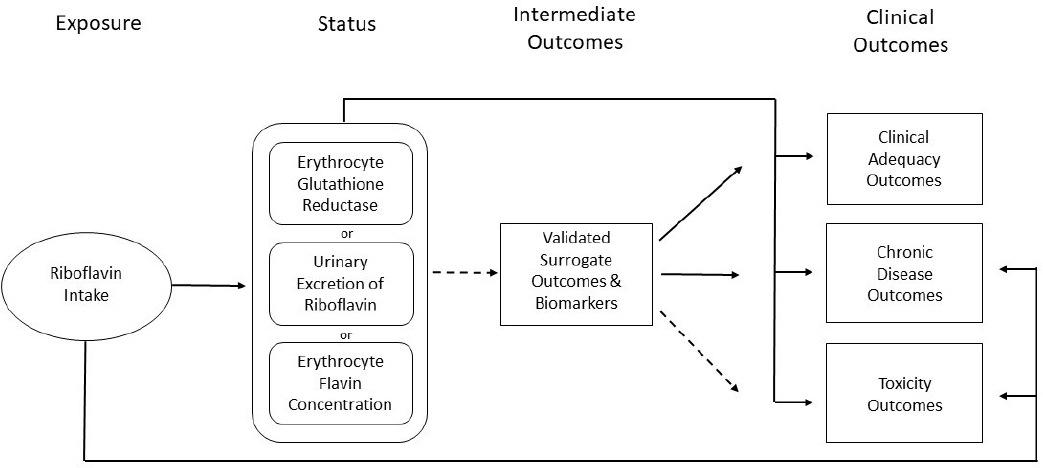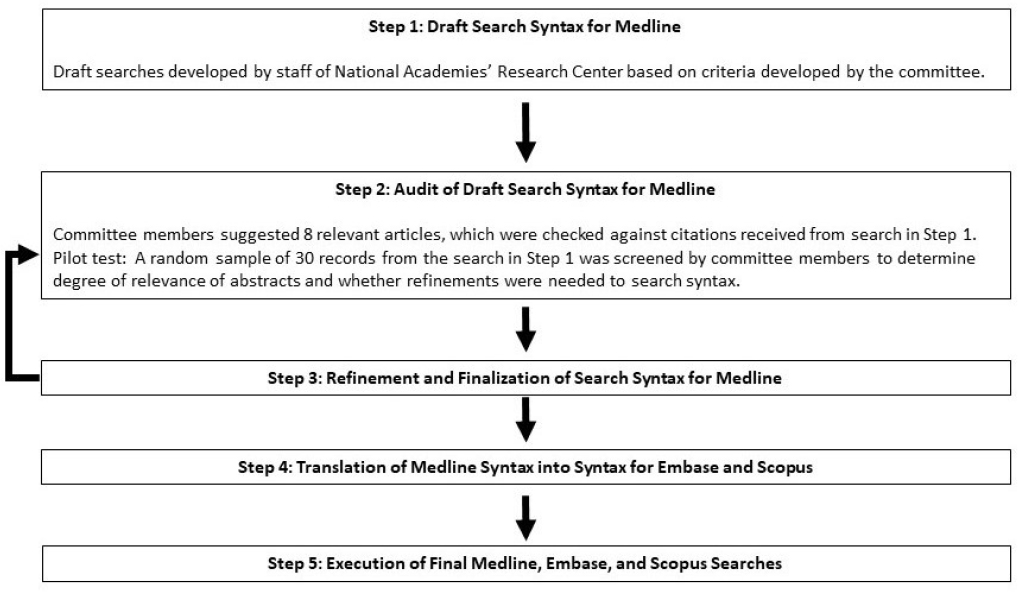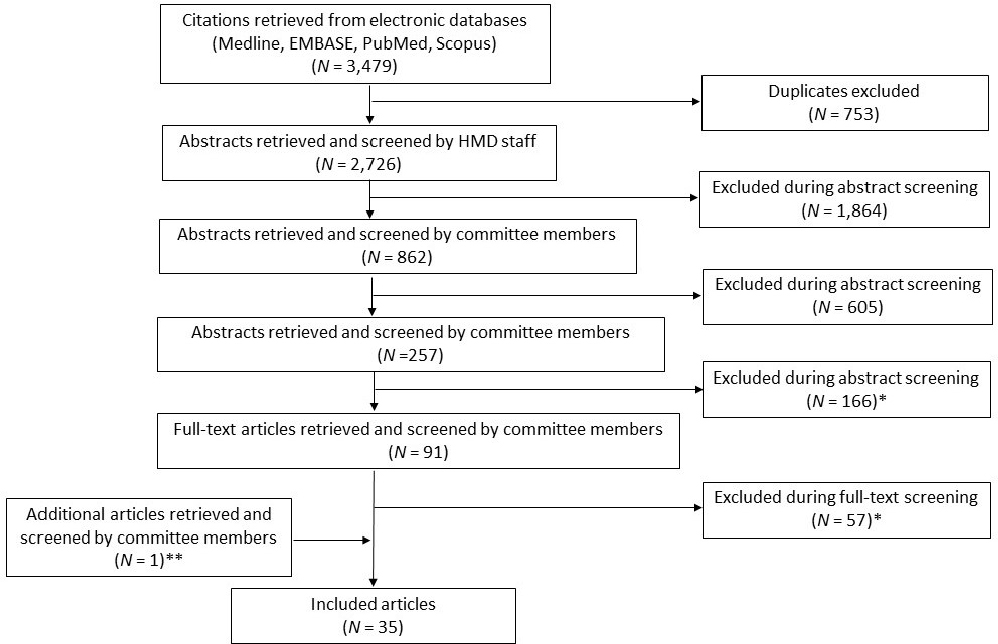Abstract
The first Dietary Reference Intake (DRI) reports were published between 1997 and 2005 by the Institute of Medicine of the National Academies of Sciences, Engineering, and Medicine (the National Academies) and included 29 vitamins and minerals, as well as macronutrients and other food components, such as energy and fiber. Two updated reviews were also carried out using more rigorous methodologies, including replacing the original narrative evidence reviews with nutrient- and outcome-specific systematic reviews and meta-analyses. The most recent DRI review also established a new DRI value, the chronic disease risk reduction.
In 2016, four members of the Food and Nutrition Board of the National Academies developed and published an evidence-based methodology, termed “evidence scanning.” The goal was to conduct a thorough scan of the peer-reviewed published literature to determine the status of evidence on a candidate nutrient for a DRI review. For a given nutrient that goes through an evidence scan, the findings serve as a starting point for a systematic review, thereby reducing the preparatory work on a new systematic review and saving the federal agencies time and money on each review.
The U.S. Department of Agriculture, Agricultural Research Service and the U.S. Department of Health and Human Services, Food and Drug Administration, Center for Food Safety and Applied Nutrition requested that the National Academies carry out an evidence scan on new and emerging evidence on riboflavin that could be used to support a DRI review. A committee was convened to develop a framework for scanning the peer-reviewed published literature, based on the generic analytic framework for DRIs, to assess the relation of nutrient intake to health outcomes (adequacy, risk of chronic disease, and toxicity). The committee was asked to build on the methodology for evidence scanning nutrients (which have existing DRIs) to determine whether there is new and relevant knowledge available that may merit a formal reexamination of DRIs for riboflavin.
The committee developed an analytic framework for riboflavin based on appropriate clinical and biochemical markers of adequate intake (the absence of a deficiency state), chronic disease, and excessive intakes (see Figure A-1). To guide it in developing the framework and ensure that the evidence scan was comprehensive, the committee convened a 1-day meeting with subject-matter experts to provide information in response to the following objectives:
- Identify current evidence on riboflavin and adequacy, risk of chronic disease, and toxicity;
- Develop a literature search strategy for the evidence scan; and
- Identify a methodological strategy for assessing the results of the literature search.
The committee developed and refined a set of prespecified criteria for assessing the relevance of identified evidence, using the population, interventions (exposures), comparators, outcomes, and study designs (PI[E]COD) framework.
The committee then developed a search strategy that included a search syntax comprising specific text words (i.e., natural language terms) and controlled vocabulary terms to search relevant databases for literature published from January 1969 to January 2021. Figure A-2 shows
this strategy. An iterative process was used to assess whether the search strategy was either too broad or too narrow, and the committee refined it accordingly. All final search results were uploaded to a systematic review management program for abstract and full-text screening.
Staff performed an initial screening to remove duplicates and irrelevant articles. Then pairs of committee members independently screened the titles and abstracts of each potentially eligible article; any conflicts were resolved by discussion. The committee removed articles for any exclusion reason identified in the prespecified criteria. Following the final full-text screening, two committee members extracted relevant data for each study; one served as the primary extractor and the other as the verifier. Conflicts were resolved by discussion between the two to confirm eligibility. If they agreed that an article was eligible, data on study characteristics, population characteristics, intake assessment methods, riboflavin status, clinical outcomes, and chronic disease outcomes were extracted using a similar verification process.

NOTES: The solid lines represent established associations among factors. The dotted lines represent associations with validated surrogate outcomes and biomarkers. The arrows represent the direction of an association.
Figure A-3 shows the results at each stage of screening in the evidence scan. Thirty-five articles ultimately were included. The committee tabulated them by either adequacy or health outcome related to chronic disease (see Chapter 3, Tables 3-2 and 3-3). The descriptions in the tables include a notation of the category (adequacy, risk of chronic disease, or toxicity) identified in the analytic framework to which each relates. The framework and methodology in this report are intended to serve as a model for future evidence scans of other nutrients of interest. Collectively, these evidence scans will inform the decision-making process of identifying and prioritizing nutrients for future DRI reviews.

The committee was not asked to make recommendations, however it offers comments on the methodological approach to the evidence scan and discusses its findings and interpretation of the process to provide the study sponsors with a greater context to support their interpretation and application of the reported results. The committee identified as an important lesson learned an understanding and appreciation of the critical nature of the iterative process. This became apparent at all levels of the screening. Without the ability to refine the screening criteria and data interpretation, the committee would likely have missed relevant evidence.

* See Table 3-1 for a description of the exclusion reasons.
** This article was identified outside of the original literature search.
In developing its criteria for assessing methodological rigor, the committee realized that additional research would be useful in the future. Three priority topic areas emerged:
- In the absence of a validated biomarker or surrogate marker and/or uncertainty about dietary intake estimates, the committee perceived a need to identify a means to consider new and emerging methodologies to estimate riboflavin intake. This could include nontraditional methods to obtain estimates of nutrient status, such as -omics technology to detect riboflavin status in relevant genotypes.
- For nutrients that can reduce the risk of chronic disease, validated surrogate biomarkers of risk will be essential for identifying which nutrients are of greatest interest to further investigate their impact on physiologic outcomes related to adverse health outcomes.
- Whereas the objective of the evidence scan is to examine the state of the evidence for a given nutrient of interest, the committee notes that because nutrients are not consumed in isolation and interact metabolically, developing a strategy to scan for nutrients in related clusters may be worth considering.
This report represents the committee’s interpretation of its charge. Given the purpose of the evidence scan to identify new evidence on adequacy, risk of chronic disease, and potential toxicities, the committee saw as its challenge the need to design the search to be broad enough to
achieve its purpose but still specific enough to accurately reflect the current status of the evidence on riboflavin needed to support a DRI review.






